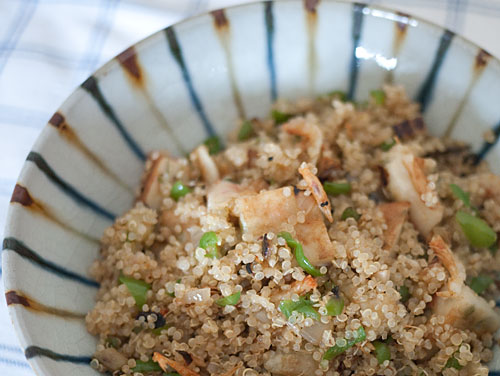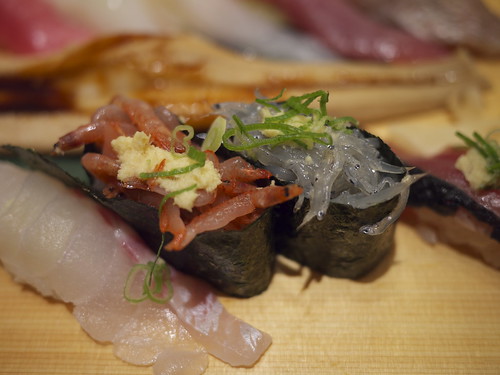Wafuu Quinoa - Quinoa with Japanese flavors

One of the fun things about hanging around in Japan is that I can experiment more freely than I can at home with some very Japanese ingredients, since they are much cheaper here. Quinoa is one of my grains (as an alternative to rice) for bentos, since it maintains its distinct, poppy texture even when cooled. As it happens, quinoa (written キヌア and pronounced as ki-nu-wa) is getting quite popular in Japan as it seems to be all over the world, and it's sold at regular supermarkets. This is quite different from the situation a few years ago when I had to smuggle a bag in for my mother to try. I married quinoa with various things that were in my mother's refrigerator that needed to be used up. We both loved the result, both hot and the next day when we had the leftovers. This should keep nicely in the fridge for at least 2-3 days. You could just pack this alone in a bento box, and you'll get all the major nutrition groups - carbs, protein, a little fat and vegetables, plus fiber - in one go.
"Wafuu" means "traditional Japanese style" by the way. Quinoa is not at all Japanese, but the flavors in this are.
Recipe: Wafuu Quinoa
3 to 4 servings
- 1 US cup (240ml) quinoa
- 1 US cup (240ml) water if using a rice cooker, 2 cups if using a pot
- 1 teaspoon dashi stock granules
- 2 green onions, chopped
- 1 piece (about 1/2 inch (1cm) long) fresh ginger, peeled and finely chopped
- about 2 cups of chopped up vegetables. I used green peppers, a mildly hot green pepper (shishito), a cabbage leaf, a bit of carrot, and some pre-cooked greens (komatsuna) - use whatever you have in your fridge
- 3 satsuma-age fish cakes (see notes), cut into dice
- 3 tablespoons dried sakura ebi (tiny dried shrimp, see notes)
- About 1 tablespoon soy sauce
- Vegetable or olive oil for cooking
- a few drops of sesame oil
- Salt and pepper to taste
Rinse the quinoa grains in a fine meshed sieve. (Note: this step may not be necessary these days, since most quinoa sold now seems to be pre-rinsed. However, it's a good idea to rinse it anyway since quinoa does have a natural soapy coating, which will taste bitter if it's not rinsed off.)
If you have a rice cooker, put the quinoa, water and the dashi stock granules (or use your own homemade dashi) into the bowl. Switch it on - use the 'rapid cooking' (i.e. no soaking time needed) setting, if your cooker has one. This is the easiest hands-free way to cook quinoa. If you don't have a rice cooker, cook the quinoa by putting 2 cups of water and the dashi granules first to a heavy-bottomed pot, bringing it up to a boil, adding the grains and then lowering the heat to a bare simmer. Put on a tight fitting lid and let cook until all the water is absorbed. This takes about 15 minutes.
In the meantime, chop and prep your vegetables. Cut up the satsuma-age.
Heat up the oil in a frying pan or wok, and add the ginger and green onions. Sauté briefly until he oil smells very fragrant. Add the sakura ebi. Add the satsuma-age and sauté until it starts to brown. Add the cup up vegetables, and sauté until tender but crisp, about 3-4 minutes.
Add the quinoa and stir well. Add the soy sauce, and a few drops of sesame oil if you like it. Season with salt and pepper to taste.
Serve hot or cold. A nice garnish for this is some shredded shiso leaves, or beni shouga (shredded pickled ginger, see okonomiyaki).
Notes
- Satsuma age are fried fish cakes, available at any Japanese grocery store. They are usually simmered in oden (you can see photos of it at that link) but it's also a popular ingredient in bentos, since it's already cooked and just has to be heated through.
- I've used sakura ebi several times before, most notably as an ingredient in okonomiyaki and in this furikake recipe. It's tiny dried shrimp, used as a flavoring ingredient. It's just packed with umami. You can find it at a Japanese grocery store. It's also a nice thing to bring back home with you from Japan, since it's much cheaper here than elsewhere.
It's fresh sakura ebi season here in Japan by the way. Here's a fresh sakura ebi sushi (next to a fresh shirasu (tiny fish) sushi) that I had the other day. (Not recommended for bentos though.)
If you enjoyed this article, please consider supporting this site by becoming my patron via Patreon.

